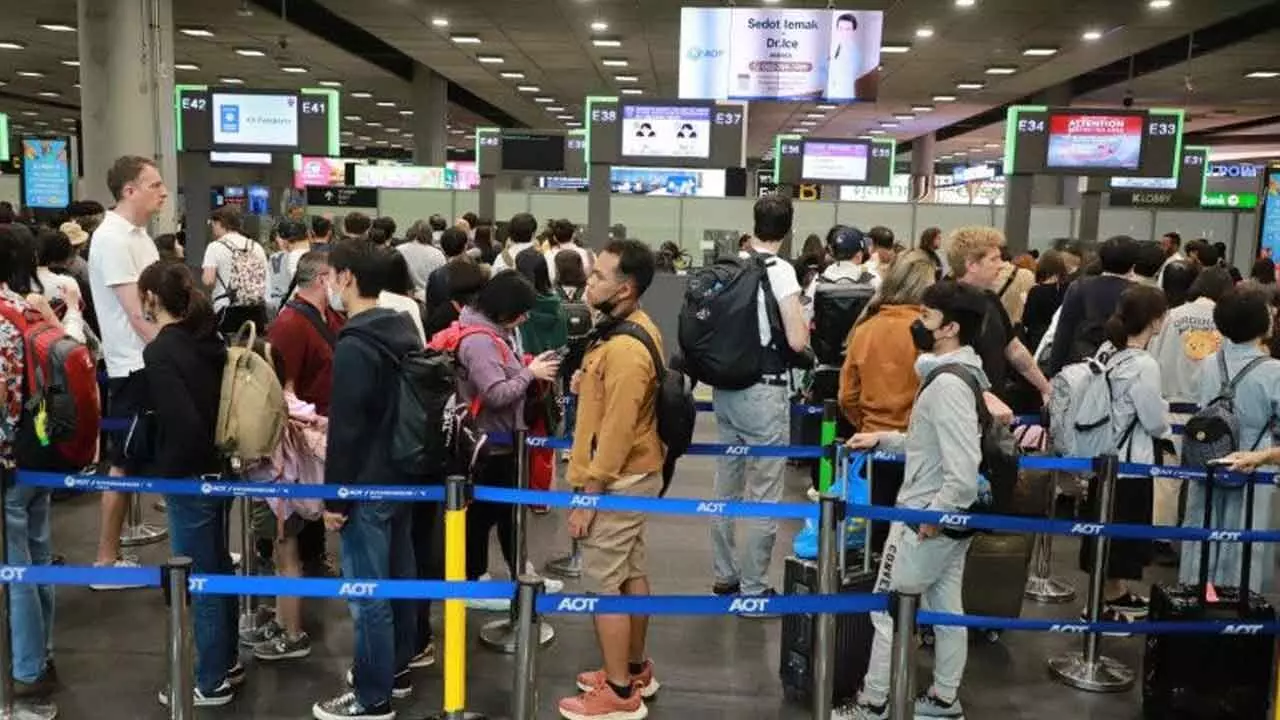Long Queues Can Adversely Impact Airport Revenues And Their Goodwill
An airport can generate $560,000 per ten lakh PAX with a two-minute decrease in wait time
Long Queues Can Adversely Impact Airport Revenues And Their Goodwill

An estimated 50,000 passengers passing through 15 different zones with 17 different queues at the same time requires a supercomputer or an AI-driven management to effectively analyse the queue environment
"India's airport operators are expected to register Rs. 359.8 billion ($4.3 billion) in revenue for FY2025, representing a growth of 14.8 per cent y-o-y from FY2024," CAPA India said.
Of the over 400 airports and airstrips in India, 135 are operational. The passenger traffic amounted to over 376 million in the financial year 2024, out of which close to 69.6 million were international passengers.
Noting that airport infrastructure at metros and non-metros is ahead of demand, it said there is an ongoing $11 billion pipeline of investment, including in Tier 2 and Tier 3 airports. However, they will need to boost their queue management if an improvement in revenue is on the agenda.
According to estimates, long queues can decrease non aeronautical revenue by $4.09 per passenger. Around 55 per cent of consumers were more likely to buy even if they have to remain in an airport concession queue for long. The average value of this purchase is $7.44 which is the global non-aeronautical revenue per passenger. Airports can realize $4.09 NAR per PAX when they spend more time in concessions through shorter wait time.
But how much time would PAX need to make this additional purchase? For business or solo travelers, an additional five minutes would be enough. For families of five people, they will likely need more than 10 minutes.
In order to simplify this variability and measure per minute impact on NAR, a scenario analysis was conducted. In an optimistic scenario, five minutes is enough for PAX to make additional $4.09 spend like coffee or a water bottle. Then one minute wait time decrease brings additional $0.82 per PAX ($4.09/5 minutes). In a realistic scenario, PAX would need additional 10 minutes to bump their grab-n-go snacks to a restaurant dine-in option.
An airport can generate $560,000 per ten lakh PAX with a two-minute decrease in wait time.
Queue management, therefore, is not just about maintaining optimal wait time and airport operations but also the single biggest factor for PAX deciding to head to their flight directly or browse retail and buy that extra cup of coffee or a bag of snack.
Check-in queues are affected by the number of airline staff processing check-ins, the number of check-in desks assigned to the airline by the airport, and the number of airport staff providing support.
It's a close collaboration between the airport, government partners and airlines. Security queues near the border require TSA, CBP and the airport staff to work together to achieve optimal wait times.
Queues can result from various factors, such as a lack of staff, improper instructions, or specific passenger characteristics or even last minute flight delays. Information should be shared with relevant stakeholders in real time to address the issue. In particular, when the queue requires additional staff, having full visibility into terminal operations is essential to avoid disrupting operations from staff reallocation.
It’s been 50 years since TSA set the security wait time goal at 10 minutes per passenger. Yet only 11 out of 130 airports deliver on that promise.
Airports’ complicated queue environments have dozens of factors that contribute to the queue at the same time as well as a changing queue environment. This makes it impossible for one entity to manually gather, synthesize and understand what is going on. Some airports have 17+ queues forming at the same time within the immigration terminal. There are queues constantly merging and separating real-time, not something a human can easily understand and manage.
An estimated 50,000 passengers passing through 15 different zones with 17 different queues at the same time requires a supercomputer or an AI-driven management to effectively analyse the queue environment.
Queue management becomes even more challenging in larger airports. Unlike a manufacturing assembly line with identical products and a defined process, passenger flow is more random and can easily go out of control. Passengers exhibit different behaviours, characteristics and personalities, which can prolong the queues, particularly for immobile passengers and families (Janssen, 2020). Some passengers do not follow compliance guidelines, further delaying the process with manual baggage checks.
The more passengers there are, the more frequent these delays occur. Juggling all these variables in a spreadsheet is how you end up with a sub-optimal plan.
Just using flight schedule data to plan staffing to meet the optimal wait time is not enough because of these unpredictable variations.
Additionally, having more airlines complicates the queue even further. Some airlines have a floating check-in desk assignment, which makes it hard for airports to define queue area to capture data per airline.
Airports can avoid this level of complexities by choosing an AI that supports this real-world complexity and fluidity.

